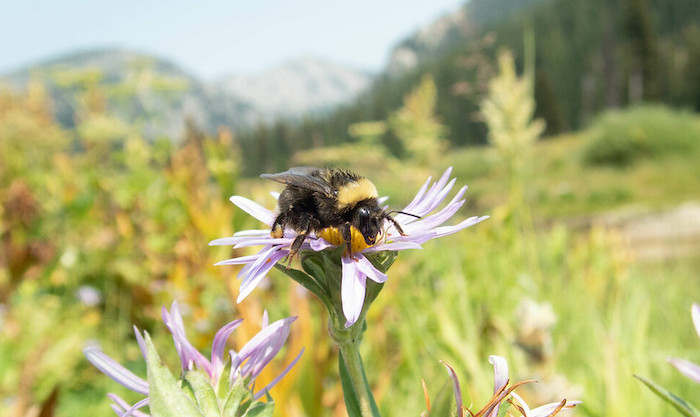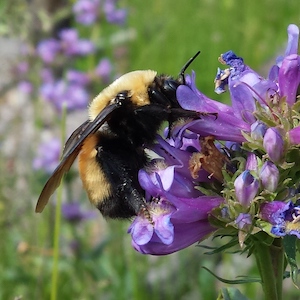Scientists are sounding the alarm about declining western bumble bees (Bombus occidentalis). "When we started our field work on bumble bees in 2015, I was hopeful that if we just did a whole lot of surveys we would find them in a least some of our study areas because there were historic records of the bees occurring in there," says IBP's meadow specialist Helen Loffland. "Over the last 5 years we have captured and released over 8000 bumble bees in our projects on the Eldorado and Plumas National Forests. We only caught 5 western bumble bees in a single year, in a single drainage on the Plumas National Forest. When we have large crews surveying all summer long in great habitat and we don’t find a species that was once common, alarm is the appropriate response."
The western bumble bee is one of many bumble bee species in decline due to a constellation of causes including habitat loss, climate change, introduced species, pesticides and disease. Now this species will be considered for listing by the U.S. Fish and Wildlife Service (USFWS) under the Endangered Species Act. To help the USFWS get the information it needs to make a listing decision, a group of 17 scientists, including Loffland, recently published a paper in the journal Ecosphere that reviews the available population data for the western bumble bee, identifies areas where more data is needed as well as priorities for future research, and proposes a sampling design to help collect needed data.

The 2019 Bee-team identifies a bumble bee caught at Lacey Meadow. The bee has been chilled briefly so it can be handled than released.
Using the existing data, the scientists found that between 1998 and 2018 there was a 93% decrease in occupancy–whether or not bees were found at a location–across the western bumble bee's range. They also identified significant areas in the US and Canada where there was no sampling, or insufficient sampling, of bumble bees to be able to tell what was happening to western bumble bee populations. The paper concludes with a request for other scientists and agencies to share bumble bee data, participate in future monitoring efforts, and help tackle research priorities.
IBP contributed data to the paper from the bumble bee research projects that we have been conducting since 2015. You might wonder how The Institute for Bird Populations got involved in bumble bee research. In 2014, IBP had been developing a project with the Eldorado National Forest looking at birds and post-fire land management, but the funding fell through. Meanwhile, the western bumblebee was added to the Forest Service's sensitive species list and Eldorado received some money from a fire settlement (fines paid by parties convicted of starting wildfires). "The Forest Service said 'what we really need is to find out if we have western bumble bees and determine if post-fire activities like herbicide treatments and brush removal would affect them. Does IBP do stuff like that?'" recounts Loffland.
So IBP expanded beyond birds to study the bees. In 2017, Loffland and colleagues published a study looking at bumble bee use of post-fire chaparral to help land managers protect bumble bees while revegetating forests after fire. Later research looked at how to restore riparian habitat to maximize benefits to bees and birds simultaneously. And earlier this year, IBP scientists and colleagues published a study identifying native plants selected by various Sierra Nevada bumble bee species. These results will help guide plant choice in reseeding and revegetation efforts.
For Loffland, the foray into insect ecology was very appealing. "As a meadow enthusiast I have long harbored the desire to explore how the plant/invertebrate/bird food web fits together," she says. In my many years working in meadows, I have marveled at the diversity and abundance of insects, and how they change over the course of a summer." She had also recently developed a fondness for bumble bees in particular. "The year before the Forest Service asked IBP about doing a bumble bee project, I had really started geeking out on bumbles and was teaching Gretchen LeBuhn's Great Sunflower Project pollinator counting protocol as an activity for my daughter's elementary school NatureBowl team," Loffland says. "Maybe I knew subliminally that bumble bees were in my future. Now I take my insect net everywhere I go."
Which is good because IBP's work on bumble bees in the Sierra, and this western bumble bee project specifically, continues. We will continue to share the results of our bumble research projects, which this summer will include surveys at three restored meadows in the Sierra Nevada. In addition, we are seeking grant funding to conduct western bumble bee surveys in areas identified in the Ecosphere paper as having insufficient data.
"We have submitted proposals to funding sources to complete surveys in 2021 to fill information gaps in far northeastern California," says Loffland. In addition to the information gaps for this region, Loffland was surprised by the dearth of bumble bee data for Nevada in particular. "I have repeatedly applied for grants to do surveys there but have not been successful yet. IBP will contribute in any way we can, but our ability to do the large amount of surveys required will depend on securing outside funding," she says. "I plan to conduct a few surveys on my personal time in 2021 in Nevada. It is really a labor of love by all the partners involved."
How do you get a bumble bee out of a net? Very carefully. Helen Loffland transfers a bumble bee caught by Rodney Siegel to a vial for identification and photography. The bee will later be released unharmed.






